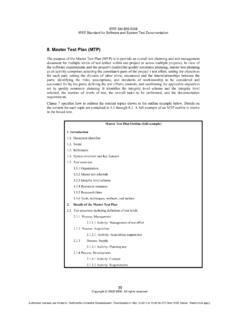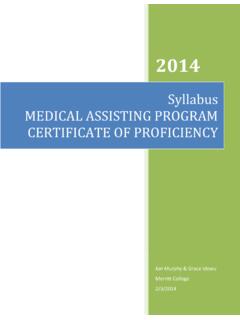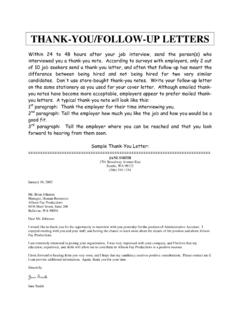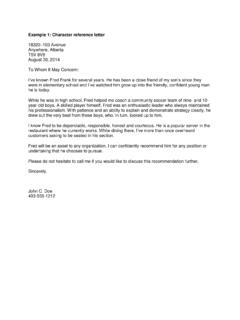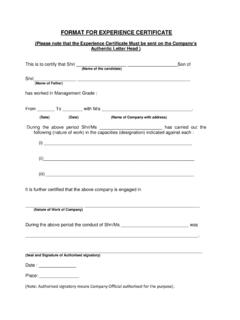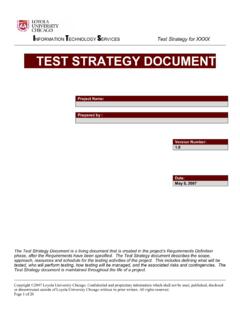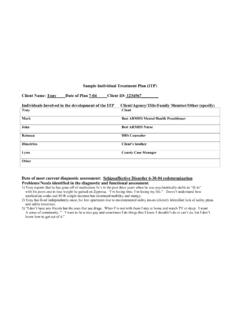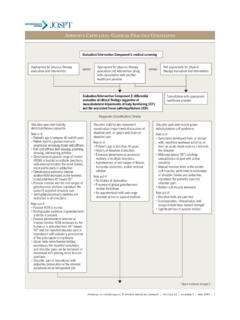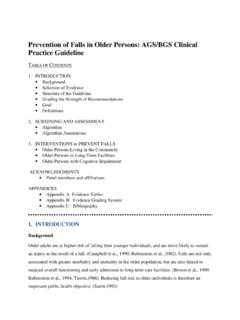Transcription of Nursing Quality and Performance Improvement Plan
1 September 109/24/2010 Nursing Quality and Performance Improvement plan Purpose Nurse involvement is essential to any significant healthcare Improvement initiative (Bosagnano, 2010). The Vanderbilt University Medical Center Nursing Quality and Performance Improvement plan (NQPIP) establishes a framework for placing Nursing on the frontlines of transforming healthcare across the Vanderbilt Clinical Enterprise. In support of the VUMC 2010-2013 Nursing Strategic plan , the NQPIP specifies those activities which ensure highly reliable personalized care while taking advantage of Vanderbilt nurses capabilities and the unique contributions of the entire care delivery team. Utilizing the Institute for Healthcare Improvement six recommendations for improving healthcare Quality and safety through the framework of Nursing , goals, objectives and strategies have been established. Each is grounded in the Institute of Medicine call for Improvement in six dimensions of healthcare.
2 Goal: Focus on transformational leadership at all levels of Nursing Objectives: Develop transformational leaders who can create and implement programs/products/environments to meet the patient population needs and VUMC organizational annual Quality pillar goals Engage and empower nurses to act as leaders in ensuring high Quality patient care Safe: avoiding injuries to patients from the care that is intended to help them Effective: providing services based on scientific evidence to all who could benefit and refraining from providing services to those not likely to benefit avoiding underuse and overuse Patient-centered: providing care that is respectful of and responsive to individual patient preferences, needs and values, and ensuring that patient values guide all clinical decisions Timely: reducing wait times and potentially harmful delays for both those who receive and give care Efficient: avoiding waste (administrative and operational) particularly waste of equipment, supplies, and human resources Equitable: providing care that does not vary in Quality because of person characteristics such as age, gender, ethnicity, geographic location and socioeconomic status.
3 (IOM 6 Aims for Improvement in the 21st century Health Care System) 2 Provide organizational learning opportunities for individual leaders and leadership teams to learn together and obtain or create tools to meet their desired objectives. Strategies: Partner with Owen School Business and the Vanderbilt School of Nursing to identify an appropriate assessment tool to conduct a gap analysis of the current state of knowledge about Quality and patient safety Train nurses at all levels in Quality Improvement and care process redesign through a series of programs to include: Center for Frontline Nursing Leaders Exploring Executive Excellence (E3) mentoring program Shared Governance programs Poster presentations and educational offerings Utilize the Nursing Shared Governance model and unit boards as a platform to involve nurses in leading process Improvement and patient safety initiatives Goal: Redesign care to optimize nurses professional expertise and knowledge.
4 Objective: Lead the nation in producing evidence that will drive Nursing practice, recognizing and legitimizing the evolution of knowledge in a rapidly changing environment. Develop documentation and care systems which support nurse workflow in order to optimize the nurse and patient interaction wherever it may occur. Strategies: Conduct lit review of personalized health care and highly reliable systems Assess and secure organizational synergy for redesign of Nursing care and secure appropriate resources Collaborate with CCI to develop methodology for determining key drivers of highly reliable personalized care Perform analysis of patient care and experience in 2-3 patient care areas Demonstrate Improvement in outcomes as specified in the fiscal year VUMC Quality Pillar Goals (Appendix I) Goal: Engage nurses to work with other members of the healthcare team to ensure safe and reliable care Objective Consistently achieve and exceed all of the publicly reported and internally developed core measures targets as well as comply with all regulatory standards.
5 3 Reduce hospital acquired condition rates to be at or below the established target for all state and CMS reported conditions. Support the deployment and use of evidence based order sets and decision making where applicable Reduce the potential risk for known high-risk processes. Strategies Engage nurses at all levels in the development and execution of focused initiatives designed for the care team on an annual basis as part of the VUMC Quality Pillar Goal development process Focused initiatives will be developed based on the following criteria: High risk events High volume events Problem-prone events Impact on satisfaction (patient, family, physician or staff) Impact on patient outcome Relationship to mission, vision, strategic plan Relationship to regulatory/accrediting requirements Measurability Impact on efficiency/operating costs Relationship to staffing effectiveness Relationship to community needs and changes Relationship to changes in environment of care Duration of benefit Create passion and discipline for the translation of evidence into practice that will optimize patient outcomes Train nurses at all levels to perform comprehensive literature reviews, to evaluate research and to take the knowledge gained to develop plans to change Nursing practice at the bedside.
6 Utilize all members of the multidisciplinary team in design of care systems to ensure holistic approach to care of patients . Goal: Build systems and a culture of safety that encourage, support and spread vitality and teamwork in all areas of Nursing Objectives: Utilize evidence based practices designed to reduce error and improve patient safety optimize healthcare team Performance through initiatives designed to improve communication and create a shared understanding of the patient and family condition Develop a culture of safety which is not accepting of healthcare acquired conditions and encourages practices designed to prevent such Create a just culture for encouraging learning about patient safety events 4 Strategies Apply core principles to all work and process design: Simplify Standardize Reduce reliance on memory Utilize forcing functions Proactively plan for demand Utilize redesigned handover and universal protocol processes to enhance communication and reduce the chance for error Incorporate best practices into care delivery including but not limited to: Medication administration safety CLABSI protocol Rapid response team VAP protocol Hand hygiene Blood administration Universal Protocol Handovers Goal: Put in places structures and processes that ensure patient-centered care Objectives: Involve the whole person and family in determining the plan of care Respect individual values and choices Ensure continuity of care Strategies.
7 Develop and implement improved patient and family education materials and processes Provide additional interpreter services to better serve non-English speaking individuals Enable nurses to work with the health care team to reliably meet the needs and preferences of patients by including the patient and family in informed and shared decision-making Utilize the Patient and Family Council as a forum for receiving feedback about ways to improve the Quality of care and patient safety Create and support Improvement and design teams where nurses, patients and families are engaged to help design systems that are patients centered. 5 Goal: Establish a Quality learning system so that nurses at all levels throughout VUMC have access to measurement and feedback about innovative care delivery Objectives: Roll out creative learning strategies (online, classroom, mentor) as an active participant in the VUMC wide initiative to develop a Quality learning system Develop definitions and tools to measure learning effectiveness that are focused around the Vanderbilt Pillar Goals and appropriate specific indicators Strategies Develop training modules regarding measurement issues (question formulation, data collection, data interpretation, results application for Improvement ) for Nursing leaders and staff.
8 Ensure benchmarking tools are available, understood and applied consistently across Nursing areas Develop Nursing champions for patient safety and Quality that spread across units/areas Utilize the Nursing Quality Council as a forum for sharing information about Quality and patient safety care model changes developed by nurses Model for Improvement The Vanderbilt Nursing Quality and Performance Improvement plan has as its foundation the IHI Model for Improvement as the method for accelerated Improvement initiatives: The Model for Improvement ,* developed by Associates in Process Improvement , is a simple yet powerful tool for accelerating Improvement . The model is not meant to replace change models that organizations may already be using, but rather to accelerate Improvement . This model has been used very successfully by hundreds of health care organizations in many countries to improve many different health care processes and outcomes.
9 The model has two parts: Three fundamental questions, which can be addressed in any order. The plan -Do-Study-Act (PDSA) cycle** to test and implement changes in real work settings. The PDSA cycle guides the test of a change to determine if the change is an Improvement . Including the right people on a process Improvement team is critical to a successful Improvement effort. Teams vary in size and composition. Each organization builds teams to suit its own needs. 6 Forming the Team Setting Aims Improvement requires setting aims. The aim should be time-specific and measurable; it should also define the specific population of patients that will be affected. Establishing Measures Teams use quantitative measures to determine if a specific change actually leads to an Improvement . Selecting Changes All Improvement requires making changes, but not all changes result in Improvement . Organizations therefore must identify the changes that are most likely to result in Improvement .
10 Testing Changes The plan -Do-Study-Act (PDSA) cycle is shorthand for testing a change in the real work setting by planning it, trying it, observing the results, and acting on what is learned. This is the scientific method used for action-oriented learning. Nursing Quality Performance and Improvement Infrastructure and Accountability Medical Center Medical Board Provides oversight for overall Quality of care and patient safety Medical Center Quality and Patient Safety Council Holds accountability and provides final direction for all Quality management and safety related activities Executive Chief Nursing Officer (ECNO) Responsible for the oversight of the Quality , Safety and Performance Improvement Programs for Nursing by: Leading cultural change Appointing and holding Nursing leaders accountable for patient safety and Quality outcomes Creating a non-punitive, just culture that encourages reporting Providing shared leadership Building external partnerships Developing leadership competencies Creating unrelenting champions of Quality and safety 7 Nursing Executive Board (NEB) Holds accountability for Quality Nursing care and patient outcomes by setting strategic direction within Nursing .
